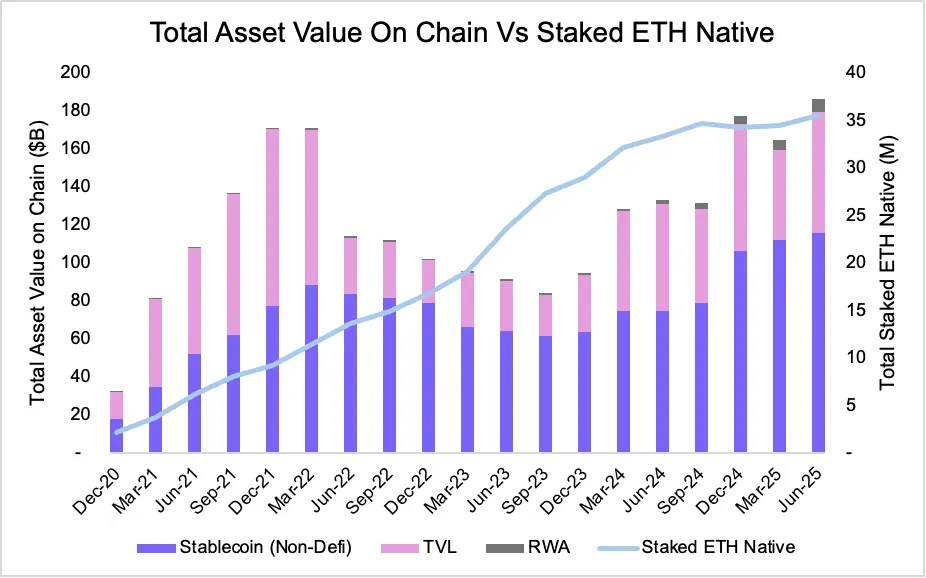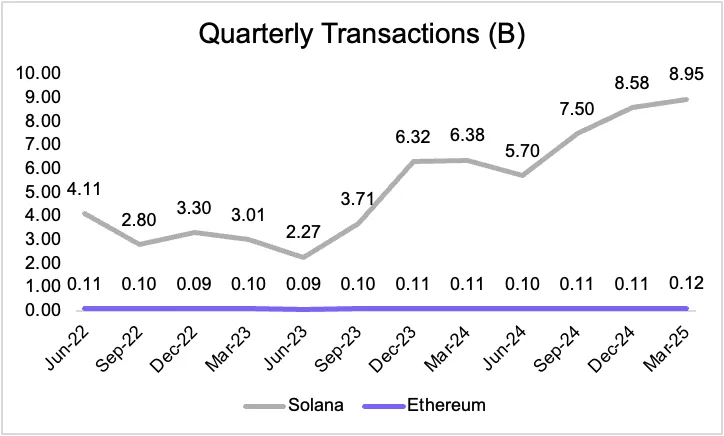From Misunderstanding to Becoming the Reserve Asset of On-Chain Economy: The Rise of ETH
Original Title: "Artemis Research: Why Has ETH Become the Reserve Asset of the On-Chain Economy?"
Original Author: Kevin Li
Original Compilation: Deep Tide TechFlow
Recently, there has been a renewed surge of interest in Ethereum, especially following the emergence of ETH as a reserve asset. Our fundamental analysts have explored ETH's valuation framework and constructed a compelling long-term bull market forecast. As always, we are happy to connect and exchange ideas with you—remember to do your own research (DYOR).
Let's delve into ETH with our fundamental analyst Kevin Li.
Key Takeaways
Ethereum (ETH) is transitioning from a misunderstood asset to a scarce, programmable reserve asset that secures and powers a rapidly compliant on-chain ecosystem.
ETH's adaptive monetary policy is expected to reduce inflation—even with 100% of ETH staked, the inflation rate would peak at approximately 1.52%, decreasing to about 0.89% by the 100th year (2125). This is significantly lower than the U.S. M2 money supply's annual growth rate of 6.36% (1998-2024) and even comparable to gold's supply growth rate.
Institutional adoption is accelerating, with companies like JPMorgan and BlackRock building on Ethereum, driving sustained demand for ETH to secure and settle on-chain value.
The annual correlation between on-chain asset growth and native ETH staking exceeds 88%, highlighting strong economic alignment.
The U.S. Securities and Exchange Commission (SEC) issued a policy note on staking on May 29, 2025, reducing regulatory uncertainty. Ethereum ETF filings now include staking provisions, enhancing returns and strengthening institutional alignment.
ETH's deep composability makes it a productive asset—usable for staking/restaking, as DeFi collateral (e.g., Aave, Maker), AMM liquidity (e.g., Uniswap), and as the native gas token on Layer 2.
While Solana has gained attention for Memecoin activity, Ethereum's stronger decentralization and security enable it to dominate high-value asset issuance—a larger, more enduring market.
The rise of Ethereum reserve asset trading, starting with Sharplink Gaming ($SBET) in May 2025, has led to publicly traded companies holding over 730,000 ETH. This new demand trend mirrors the 2020 Bitcoin reserve asset trading wave and has contributed to ETH's recent outperformance of BTC.
Not long ago, Bitcoin was widely regarded as a compliant store of value—its narrative as "digital gold" seemed fanciful to many. Today, Ethereum (ETH) faces a similar identity crisis. ETH is often misunderstood, with underperforming annual returns, missing key meme cycles, and experiencing slowed retail adoption across much of the crypto ecosystem.
A common critique is that ETH lacks a clear value accumulation mechanism. Critics argue that the rise of Layer 2 solutions erodes base layer fees, undermining ETH's status as a monetary asset. When viewed primarily through the lens of transaction fees, protocol revenue, or "real economic value," ETH begins to resemble a cloud computing security—more akin to Amazon's stock than a sovereign digital currency.
In my view, this framework constitutes a misclassification. Evaluating ETH solely through cash flows or protocol fees conflates fundamentally different asset classes. Instead, it is better understood through a commodity framework similar to Bitcoin. More accurately, ETH constitutes a unique asset class: a scarce yet productive, programmable reserve asset whose value accumulates through its role in securing, settling, and driving an increasingly institutionalized, composable on-chain economy.
Fiat Currency Devaluation: Why the World Needs Alternatives
To fully grasp ETH's evolving monetary role, it must be placed within the broader economic context, especially in an era of fiat devaluation and monetary expansion. Driven by ongoing government stimulus and spending, inflation rates are often understated. Although official CPI data show inflation hovering around 2% annually, this metric may be adjusted and could mask true declines in purchasing power.
Between 1998 and 2024, CPI inflation averaged 2.53% annually. In contrast, the U.S. M2 money supply grew at an annual rate of 6.36%, outpacing inflation and home prices and approaching the S&P 500's 8.18% return. This even suggests that nominal stock market growth may stem more from monetary expansion than productivity gains.

Durability—it must withstand the test of time without degradation.
Value preservation—it should maintain purchasing power throughout market cycles.
Liquidity—it must be easily tradable in active markets.
Adoption and trust—it must be widely trusted or adopted.
Today, ETH excels in durability and liquidity. Its durability stems from Ethereum's decentralized and secure network. Its liquidity is also high: ETH is the second-most traded crypto asset, with robust markets on both centralized and decentralized exchanges.
However, when evaluated from a purely traditional "store of value" perspective, ETH's value preservation, application, and trust remain contentious criteria. This is precisely why the concept of a "scarce programmable reserve asset" is more fitting, highlighting ETH's active role in value maintenance and trust-building alongside its unique mechanisms.
ETH's Monetary Policy: Scarce Yet Adaptive
One of the most debated aspects of ETH's role as a store of value is its monetary policy, particularly how it controls supply and inflation. Critics often point to Ethereum's lack of a fixed supply cap. However, this criticism overlooks the architectural complexity of Ethereum's adaptive issuance model.
ETH's issuance is dynamically linked to the amount of ETH staked. While issuance increases with staking participation, this relationship is sublinear: the inflation rate grows slower than the total staked. This is because issuance is inversely proportional to the square root of the total ETH staked, naturally moderating inflation.

Robinhood is developing a tokenized stock platform, JPMorgan is launching its deposit token (JPMD) on Ethereum Layer 2 (Base), and BlackRock is tokenizing a money market fund on the Ethereum network using BUIDL.
This on-chain process is driven by a strong value proposition that addresses legacy inefficiencies and unlocks new opportunities:
Efficiency and Cost Reduction: Traditional finance relies on intermediaries, manual steps, and slow settlement processes. Blockchain streamlines these through automation and smart contracts, reducing costs, minimizing errors, and cutting processing time from days to seconds.
Liquidity and Fractional Ownership: Tokenization enables fractional ownership of illiquid assets like real estate or art, expanding investor access and unlocking trapped capital.
Transparency and Compliance: Blockchain's immutable ledger ensures verifiable audit trails, simplifying compliance and reducing fraud through real-time transaction and asset ownership visibility.
Innovation and Market Access: Composable on-chain assets allow for new products (e.g., automated lending or synthetic assets), creating new revenue streams and expanding financial reach beyond traditional systems.
ETH Staking as Security and Economic Alignment
The migration of traditional financial assets on-chain highlights two primary drivers of ETH demand. First, the growth of real-world assets (RWAs) and stablecoins increases on-chain activity, boosting demand for ETH as a gas token. More importantly, as observed by Tom Lee, institutions may need to purchase and stake ETH to secure the infrastructure they rely on, aligning their interests with Ethereum's long-term security. In this context, stablecoins represent Ethereum's "ChatGPT moment," a major breakthrough use case showcasing the platform's transformative potential and broad utility.
As more value settles on-chain, the alignment between Ethereum's security and its economic value becomes increasingly critical. Ethereum's finality mechanism, Casper FFG, ensures blocks are finalized only when a supermajority (two-thirds or more) of staked ETH reaches consensus. While an attacker controlling at least one-third of staked ETH cannot finalize malicious blocks, they can disrupt finality by breaking consensus. In such scenarios, Ethereum can still propose and process blocks, but without finality, these transactions could be reversed or reordered, posing serious settlement risks for institutional use cases.
Even when operating on Layer 2s that rely on Ethereum for final settlement, institutional participants depend on the base layer's security. Layer 2s do not detract from ETH; instead, they enhance its value by driving demand for base-layer security and gas. They submit proofs to Ethereum, pay base fees, and typically use ETH as their native gas token. As rollups scale execution, Ethereum accumulates value through its foundational role in providing secure settlement.
Long-term, many institutions may move beyond passive staking via custodians to operate their own validators. While third-party staking solutions offer convenience, running validators gives institutions greater control, enhanced security, and direct participation in consensus. This is particularly valuable for stablecoin and RWA issuers, as it allows them to capture MEV, ensure reliable transaction inclusion, and leverage private execution—features critical to maintaining operational reliability and transaction integrity.
Importantly, broader institutional participation in validator operations helps address one of Ethereum's current challenges: the concentration of stake among a few large operators, such as liquid staking protocols and centralized exchanges. By diversifying the validator set, institutional participation enhances Ethereum's decentralization, resilience, and credibility as a global settlement layer.
A notable trend from 2020 to 2025 reinforces this incentive alignment: the growth of on-chain assets closely correlates with staked ETH growth. As of June 2025, the total stablecoin supply on Ethereum reached a record $116.06 billion, while tokenized RWAs climbed to $6.89 billion. Meanwhile, staked ETH grew to 35.53 million ETH, a significant increase highlighting how network participants balance security with on-chain value.

Source: Artemis
A recent policy clarification by the U.S. Securities and Exchange Commission (SEC) alleviated regulatory uncertainty around Ethereum staking. On May 29, 2025, the SEC's Division of Corporation Finance stated that certain protocol staking activities—limited to non-entrepreneurial roles, such as self-staking, delegated staking, or custodial staking under specific conditions—do not constitute securities offerings. While more complex arrangements remain subject to case-by-case determination, this clarification encourages more active institutional participation. Post-announcement, Ethereum ETF filings began incorporating staking provisions, allowing funds to earn rewards while securing the network. This not only enhances returns but also further solidifies institutional acceptance and trust in Ethereum's long-term adoption.
Composability and ETH as a Productive Asset
Another distinguishing feature of ETH, setting it apart from purely store-of-value assets like gold and Bitcoin, is its composability, which itself drives demand for ETH. Gold and BTC are non-productive assets, while ETH is natively programmable. It plays an active role in the Ethereum ecosystem, powering decentralized finance (DeFi), stablecoins, and Layer 2 networks.
Composability refers to the ability of protocols and assets to interoperate seamlessly. On Ethereum, this enables ETH to serve not just as a monetary asset but as a foundational building block for on-chain applications. As more protocols are built around ETH, demand for ETH grows—not just as gas but also as collateral, liquidity, and staked capital.
Today, ETH is used for several critical functions:
Staking and Restaking—ETH secures Ethereum itself and can be restaked via EigenLayer to provide security for oracles, rollups, and middleware.
Collateral in Lending and Stablecoins—ETH backs major lending protocols like Aave and Maker and underpins overcollateralized stablecoins.
Liquidity in AMMs—ETH pairs dominate decentralized exchanges like Uniswap and Curve, enabling efficient exchange across the ecosystem.
Cross-Chain Gas—ETH is the native gas token for most Layer 2s, including Optimism, Arbitrum, Base, zkSync, and Scroll.
Interoperability—ETH can be bridged, wrapped, and used on non-EVM chains like Solana and Cosmos (via Axelar), making it one of the most widely transferable on-chain assets.
This deeply integrated utility makes ETH a scarce yet productive reserve asset. As ETH becomes more embedded in the ecosystem, switching costs rise, and network effects strengthen. In a sense, ETH may resemble gold more than BTC does. Much of gold's value comes from industrial and jewelry applications, not just investment. In contrast, BTC lacks such functional utility.
Ethereum vs. Solana: Layer-1 Divergence
In this cycle, Solana appears to be the biggest winner in the Layer 1 space. It has effectively captured the memecoin ecosystem, creating a vibrant network for new token issuance and development. While this momentum is real, Solana's decentralization remains inferior to Ethereum's due to its limited validator count and higher hardware requirements.
That said, demand for Layer 1 block space may become stratified. In this layered future, both Solana and Ethereum can thrive. Different assets require different trade-offs between speed, efficiency, and security. Long-term, however, Ethereum—with its stronger decentralization and security guarantees—may capture a larger share of asset value, while Solana captures higher transaction frequency.

Figure 13: ETH and BTC Price Trends
Stay tuned for our upcoming research report, which will delve deeper into the evolving landscape of Ethereum's fiscal adoption!
Conclusion: ETH as the Reserve Asset of the On-Chain Economy
Ethereum's evolution embodies a broader paradigm shift in the concept of monetary assets in the digital economy. Just as Bitcoin overcame early skepticism to earn recognition as "digital gold," Ether (ETH) is forging its own identity—not by mimicking Bitcoin's narrative but by evolving into a more versatile, foundational asset. ETH is neither akin to a cloud computing security nor limited to being a utility token for transaction fees or protocol revenue. Instead, it represents a scarce, programmable, and economically essential reserve asset—one that underpins the security, settlement, and functionality of an increasingly institutionalized on-chain financial ecosystem.
Original Link
